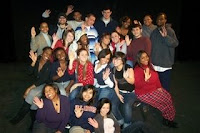On Monday March 10 the Urbana (IL) City Council tabled consideration of creating a public arts commission. This was somewhat discouraging for the public arts task force. At least the Council didn’t vote it down. For what it is worth, here’s what I wrote to the Council about the importance of supporting the arts in Urbana (and the world.) I have added some images and I was fortunate enough tonight to see the play by Ruth Nicole Brown, “Endangered Black Girls.” (It was a really packed house.)
The public arts task force has worked for the past year on crafting an arts commission structure and mission that I believe will put Urbana on the map for its leadership in supporting the arts and for its recognition that the arts are integral to a healthy, vibrant community, economically and otherwise.
As an arts educator, I have had the opportunity to work in art-related fields for over twenty years. I use the term “art” broadly and would like to share three examples of how the arts
-not only offer students new ways to communicate and thrive,
-not only offer people compelling reasons to move here and remain in town, and
-not only offer visitors reasons to return to Urbana,
BUT ALSO how the arts contribute significantly to addressing issues of common concern. The arts are not an “extra” except in the sense that they are often extraordinary in their ability to draw people into conversation, into action, into new understandings.
Current local artistic activities include powerful expressions, but they occur because of the dedicated commitment on the part of a few. Forty North is an important partner in some of these activities, but that organization, too, would benefit from municipal recognition of their efforts. Often, local artists produce one-time events by cobbling together support from existing groups, but there is no continuity, no public rehearsal space, and few affordable outlets for youngsters to learn music, dance and visual art, for example.
EXAMPLE #1: This week the Inner Voices Social Issues Theatre (sponsored by UIUC Counseling Center, McKinley Heath Center, and the Department of Theatre) is performing the work of a local playwright, Ruth Nicole Brown, called “Endangered Black Girls,” based on the lives of local young women, at the Armory Free Theatre. While it is fantastic that this play is being produced, we need more of  this sort of contribution. The time to understand what Dr. Brown’s work has to communicate is now as WILL’s Youth Media Workshop has made abundantly clear. Young people in our town do not see the community as offering any resources to help them achieve their goals. Angela Evans, who almost single-handedly coordinates “Black Stars” for girls has told me that she is desperate for accessible rehearsal space, for instance. Making space for these activities is supporting the arts in ways that are not happening now.
this sort of contribution. The time to understand what Dr. Brown’s work has to communicate is now as WILL’s Youth Media Workshop has made abundantly clear. Young people in our town do not see the community as offering any resources to help them achieve their goals. Angela Evans, who almost single-handedly coordinates “Black Stars” for girls has told me that she is desperate for accessible rehearsal space, for instance. Making space for these activities is supporting the arts in ways that are not happening now.
EXAMPLE #2: Cecilia Vicuña, a Chilean artist, has been collecting seeds from native plants since 1973. This 35-year project is part science, part art, part politics, in that after her exile from Chile in 1973, she moved to England and continued to collaborate with scientists there to promote plantings that would stop the denuding and erosion of the central areas in Chile with which she was most familiar. She has continued to promote her work through the publication of her poems, through public speaking, and through her sculptures and performances. She now regularly returns to Chile from California. This too is art and this too fosters change for the better, I believe.
EXAMPLE #3: California-based artist Suzanne Lacy worked for ten years in Oakland, California, on a series of workshops and performances that involved local youth. One of the key areas of concern in that diverse city was the tension between young people and police. Lacy creatively mixed parades, video interviews, basketball games, and face-to-face conversations between young people and police officers (1991-2001) to create awareness of different viewpoints, funding for youth activities, and roles for young people in creating policies that affected and supported them. This too is art.
With these examples, I hope I have shown how diverse artistic activities may be, how they can appeal to a wide range of people, how they promote new attitudes that increase human potential. Urbana needs a public art commission for all these reasons. Thank you.
